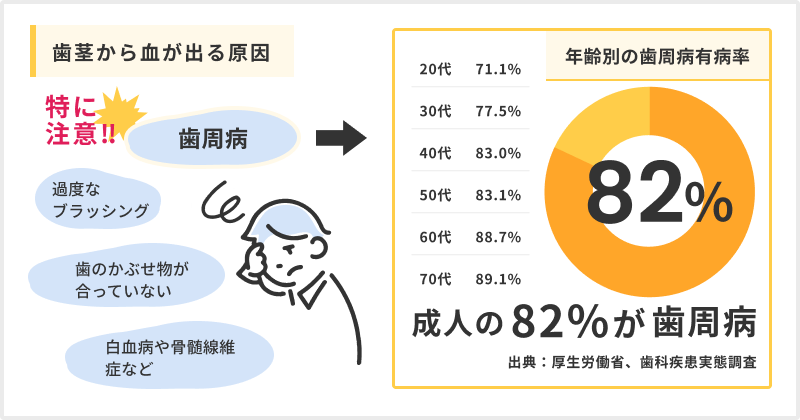Periodontal Disease and Bleeding Gums – Causes, Treatment and Self-check

Contents
Symptoms of bleeding gums can be caused by gum disease, improper brushing, or diseases such as leukemia or myelofibrosis (bone marrow fibrosis), but most are caused by gum disease.
Children who have bleeding gums that do not stop need to see a dentist, but adults should also see a dentist as soon as possible because gum disease can lead to tooth decay and tooth loss if left untreated.
Causes of bleeding gums

Periodontal Disease (Gum Disease)
Periodontal disease is caused by an infection of the gums that destroys the gum tissue, causing the teeth to loosen and become painful. The disease is unnoticeable in the early stages and progresses rapidly if left untreated. As it progresses, it also dissolves the bone around the teeth. It is one of the causes of bad breath and is a sign that you should seek treatment as soon as possible.
Excessive brushing
In some cases, brushing with more force than necessary can damage the gums and cause them to bleed. If the same area is not brushed excessively, the gums will gradually recover in a few days.
Gum line reaching tooth decay
If the decay is large and has reached the gum line, the area will bleed due to inflammation.
Not fitting fillings
When fillings do not fit, the gums might get inflamed.
Leukemia, myelofibrosis, etc.
If there is no specific problem such as gum disease or tooth decay, it is recommended to consult an appropriate specialist as there is a possibility of blood or internal organ diseases.
Symptoms of Periodontal Disease

Periodontal disease has no symptoms in the early stages, but it progresses rapidly and by the time pain occurs, the disease may have progressed to the terminal stage. If left untreated, the disease can affect the bone that supports the teeth and lead to pain and eventually tooth loss.
Healthy Condition
The gums are clean, pink and firm, and there are no gaps – called periodontal pockets – between the teeth and gums.
Early Stage
Periodontal pockets are less than 4 mm deep, have no averse symptoms, and may be overlooked because they look like healthy teeth.
Middle Stage
Pockets are 5 mm to 7 mm deep and there still might be no symptoms. The gums are red and the teeth begin to loosen. Bleeding may be occur when the teeth are brushed.
Late Stage
The periodontal pockets are more than 8 mm deep, and as the disease progresses, the teeth loosen significantly, the gums are swollen and reddish-purple, and bleeding or yellow pus is seen when the gums are pressed.
Eating may also be painful. Please see your dentist as soon as possible as there is an increased chance that the tooth will need to be extracted.
Self-check for Periodontal Disease
The following symptoms are common to gum disease. By performing a self-check, you can prevent the disease from progressing.
・Gums are not pink, but red or red-purple
・The tips of the gums between the teeth are rounded
・Gums bleed when the gum line is brushed
・Pus comes out between the teeth and gums
・Blood when using an interdental brush and floss
・Teeth feel loose
・Waking up in the morning with a sticky feeling and a remaining blood taste
・Having bad breath
・Gums feel uncomfortable / strange
・There is a lot of tartar on the teeth
・Teeth seem to get longer
The Toranomon Hills Dental Medical Ryu Clinic offers free consultations for a variety of dental problems.
You can be sure that we will always make suggestions that are appropriate for your situation and that we will always work with you to determine the best treatment plan.
Please do not give up and consult with us first.




